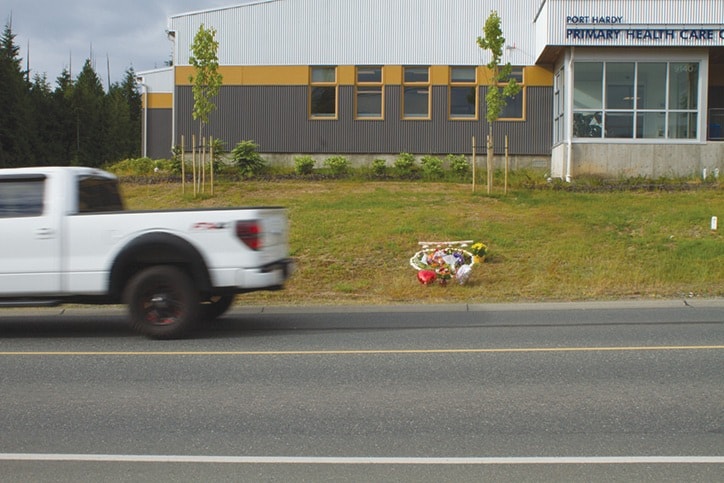A July 8 shooting in Port Hardy by an RCMP officer has left a 24-year-old man dead.
Port Hardy RCMP responded on Wednesday morning just after 11 a.m. to a complaint of a man making threats towards security staff at Port Hardy Secondary School, where a staging area for the Tsulquate River wildfire was set up. The man was allegedly wielding a knife.
Police located the suspect down the street from the school near a four-way stop at the intersection of Highway 19 and Granville Street. He was shot multiple times and did not survive his injuries. No other civilians or police were injured. Members of the Independent Investigations Office of B.C. (IIO) have taken jurisdiction over the investigation and the RCMP are not commenting on the shooting. The IIO arrived on scene early in the evening on July 8, and they are currently seeking additional witnesses as they proceed with the rest of their process.
The man’s identity was confirmed by the B.C. Coroner’s Service on July 10 as James Reginald Butters, also known as James Hayward, a 24-year-old resident of Port McNeill.
In a July 9 media release, the IIO said that one officer directly involved in the shooting has been identified. Two other witness officers present at the scene have also been identified and interviewed.
The IIO believes there may have been additional people who observed the incident at the Highway 19 and Granville Street intersection.
The intersection is beside Seawind Estates, a community of townhouses. Jennifer Taylor, who can see the shooting scene from the window of her townhouse, says that the sound of gun shots echoing off the fence in front of the street sounded like fireworks.
Taylor says that shortly after the shots were fired, a yellow tarp was placed over the body. She says that those living beside the shooting scene are “wishing that we really knew what transpired.”
An eyewitness who arrived at the scene after the shooting occurred says that the body lay out in the sun for more than eight hours. The IIO responded to questions about this duration by saying that the body cannot be moved until the coroner gives authorization and has gathered all evidence needed. Matt Brown, the regional coroner for the Island Region, said that “when these cases occur outside of urban centres, there usually is a delay in agencies attending, so you have to balance the time it takes to get there versus the need for evidence.”
The IIO reports that significant physical evidence has been seized, including a knife, and said Thursday that investigators were focusing on interviewing witnesses and examining any available cell phone video.
Ralph Krenz, spokesperson for the IIO, said as of Friday investigators from the IIO are still in Port Hardy, and the investigation is ongoing. Krenz said that after the investigation is complete, a determination will be made if there was an offence in the actions of the officer in question. If the officer is found to have not committed an offence, a public report will be issued. If the officer is unable to be cleared, a report will be issued to the Crown Council. Krenz was not able to comment on whether or not the officer directly involved has been suspended from duty.
In the days following the incident there were some questions raised online by North Island residents wondering why shots were fired at Hayward instead of a Taser being used. Dr. Rick Parent, associate director of the Police Studies Centre at Simon Fraser University, says that Tasers are not always carried by police officers.
Dr. Parent says that officers must be trained and qualified before they use one.
They are also expensive and in limited supply, meaning that even if an officer wants to use one for a shift, it may have already been signed out.
He adds that it is typically left for officers to decide if they want to sign one out for shift, and that even those who are qualified and trained may not wish to use one.
Leo Knight, a former police officer and security expert, says that after the inquiry following Robert Dziekanski’s death after being Tasered at Vancouver International Airport in 2007, the RCMP essentially rewrote their stance on Tasers. He says that if one is used directly it can drop a person to the ground, but that involves getting extremely close, a clear risk to officer safety if approaching someone wielding a weapon.
“You consider the threat to your safety, and then you respond appropriately,” Knight says.
